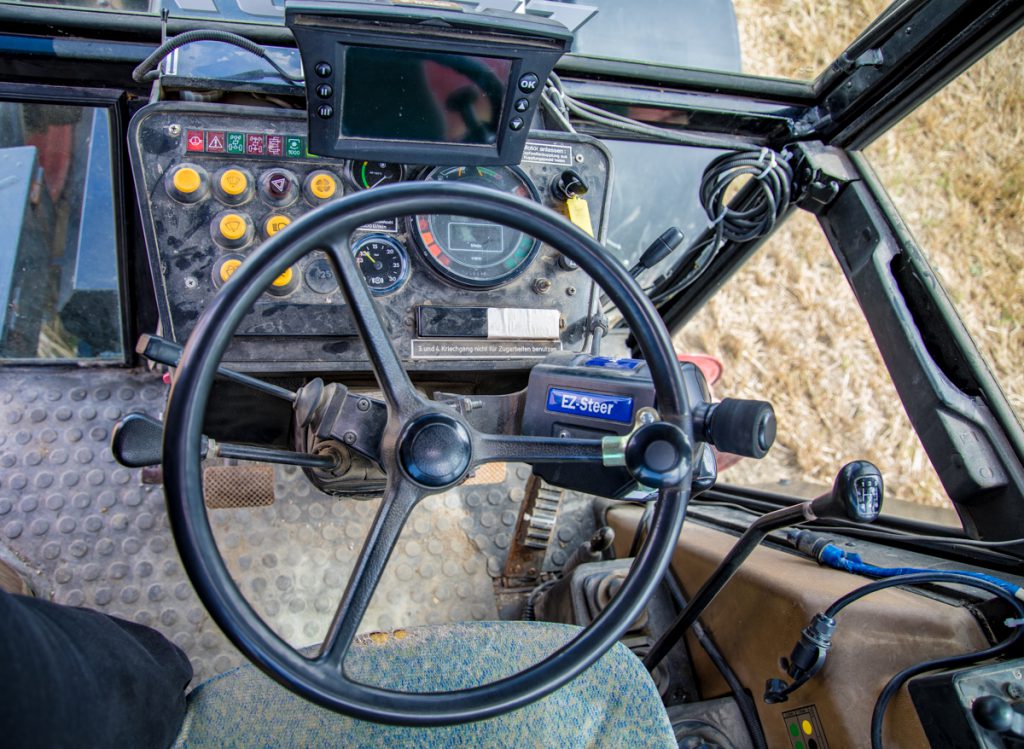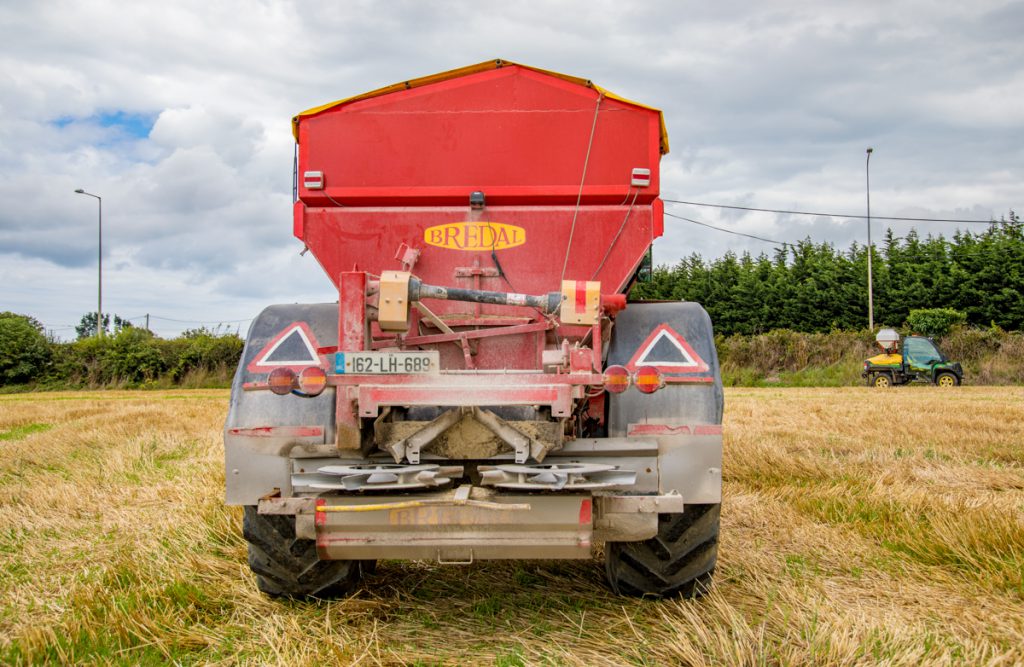Andrew Burke, based in Clogherhead, Co. Louth, has been involved in agricultural contracting since he left school. The majority of his work now entails bulk spreading – of fertiliser and lime – for Drummonds.
He runs a tight fleet – the tractors and machines each have a specific job – and he doesn’t shy away from modern technology.
Speaking to AgriLand this week, Burke gave us an insight into the operation, focusing on the machinery fleet in particular.
How did you get into the contracting business?
I started working for a local contractor – at silage – when I left school. A few years later, I bought my first tractor – a Case IH MX135. The tractor was only six months old at the time; I bought it privately.
I was kept busy hauling potatoes and doing slurry work. The hours were long and the continual road-work was hard on that tractor.
I kept it until 2003, at which point I bought a new Fendt 716 Vario from Donohoes, who had just opened a new depot in Ballyboughal. At the time, that tractor cost about €85,000 [excluding VAT]. It was a big step up – not just in horsepower but also in terms of overall build and reliability.
A year or so later, a neighbour of mine – who works for Drummonds – approached me to see if I would buy a big, trailed fertiliser spreader and go contract spreading for them. I’ve been doing that ever since – and running Fendt tractors since then too.
How loyal are you to particular brands?
I’ll probably stick with Fendt tractors now. For this sort of work, where 80% of your time could be spent out on the road on any given day, they are ideal. For its horsepower, the 720 is fairly light and compact – unlike some competing tractors.
Who is your preferred dealer?
Farmworks Machinery, in Ballyboughal, looks after my tractors. The main mechanic there – Ciaran – knows Fendt tractors inside out and is very helpful.
What is the best tractor you’ve ever had?
The 720 that I’m running as my main tractor now is easily the best yet. It’s a ProfiPlus version; it’s noticeably better than my previous, lower-spec 720. This newer version is also quieter inside the cab.
The ProfiPlus spec is good for my work; you can use one in-cab terminal for everything. You don’t have a whole lot of clutter and wiring to grapple with.
On any given day, the tractor uses about 150L of diesel; it’s very easy on fuel on the road – thanks to the Vario system.
What is the worst tractor you’ve ever had?
I’ve had quite a few tractors over the years, but I haven’t had any really bad ones. The first tractor I had – the Case IH MX135 – was a bit troublesome at times, but that’s probably because it wasn’t really designed for all the road-work I was doing.
There weren’t any really serious breakdowns, but it did need to go in for work on the gearbox, brakes and front suspension a few times. That was hassle, because you’d have to swap screens, control boxes and cables over to a replacement tractor each time.
What is your favourite piece of machinery?
I run a Lemken one-pass system – with a front-mounted furrow press – which I’m really happy with. The power harrow is a Zirkon 10; the drill is a Solitair 8. The harrow does tidy work and the drill’s seed-rate is very accurate.
It’s a great piece of equipment, but I don’t do as much sowing as I used to; I’m too busy with lime spreading at this time of year and fertiliser spreading in the spring. There just isn’t enough time!
The charge-out rate for one-pass work is usually €30/ac [excluding VAT].
The Bredal spreaders are also well-put-together machines; spreading fertiliser can be stressful at times – to ensure that the right amount goes in exactly the right place. It costs too much money to get wrong.
What is your least favourite piece of machinery?
I used to run two 2,600-gallon Ruscon slurry tanks – both single-axle machines. There was nothing particularly wrong with the machines themselves, but you’d get totally destroyed at slurry work – doing it day in day out.
That was back before the slurry ban; you’d be at it all winter. You’d be under pressure to get through work and there’d be muck out on the road – and everyone would be getting annoyed. You couldn’t win.
What is your latest purchase?
The most recent purchase is, ironically, my oldest machine. It’s a 1993 Fendt Favorit 612 LSA with almost 14,000 hours on the clock. I bought it in Germany last November.
I needed a second tractor to handle the lime spreading. Swapping the 720 over from one spreader to another so often was time-consuming; I really needed a dedicated tractor for that job – especially as the lime spreading workload was growing.
I had a maximum of €25,000 to spend on the project; I wanted a Fendt but the options are limited on that budget. I mentioned it to a contact I knew in Germany, whom I’d bought a nitrogen sensor from. He came back with an option; after a bit of haggling the deal was done.
It’s no match for the 720 when it comes to comfort, but it’s been reliable so far.
How long do you keep tractors and machinery?
I might actually upgrade the 612 next year. The lime spreading is getting busier, so it’s outgrown that tractor. All being well, I’ll be on the look-out for an ’03 or ’04 818 [Vario].
I generally keep the front-line tractor – currently the aforementioned 720 – for three or four years. It will likely clock up 3,000 or 4,000 hours in that time.
I’ve had the spreaders for longer. The older one is a 2005 Bredal K85; it spreads all the fertiliser. The other unit – also a Bredal K85 – is a 2008 model. They’re well maintained and I’m in no rush to change either.
Most useful machine?
They all have their place; the machines are usually kept busy. One surprisingly useful machine is the John Deere Gator – an 855D model. It cost about €22,000 [excluding VAT] to buy new.
It’s a bit soft for constant, agricultural work but the concept is great. It has an applicator on the back; it applies slug pellets and sows rape-seed oil and cover crops.
It even has a GPS-controlled metering system [instead of a simple gravity-type feed system] that meters out the seed; that ensures that the application rate matches the vehicle’s ground speed.
That’s important when inputs cost as much as they do nowadays – and when you’re spreading a lot.
I have a special set of tracks for the Gator; they came from the UK and cost £5,000. When they’re on, the machine can go practically anywhere and do no harm. It’s great, for example, for getting out slug pellets in bad conditions.
Any home modifications or changes to your set-up that stand out?
I got a suspended boom – that folds out to 5.5m either side of the machine – fabricated for the 2008 Bredal K85. When the discs cast out the lime, it is directed along the boom – inside the ‘curtains’. Less is blown away [and less annoyance is caused on neighbouring land]; the lime lands where it’s supposed to.
I know that Bredal does offer a factory-fitted applicator boom, but that’s a more complex unit. It has feed augers; they wouldn’t work with the variable-rate application system on this spreader.
What is your favourite machinery job?
I enjoy sowing with the Lemken one-pass. Spreading is fine too, but fertiliser work can be stressful when the pressure is on. You’ve got to concentrate on the job all the time.
The problem is; if something goes wrong you might not see striping or other problems until weeks after – it’s far too late then!
What is your least favourite machinery job?
Collecting money. I’m lucky; at the moment most of my income comes from one source. But you’ve still got to stay on top of the paperwork.
Tractors: Fendt 720 Vario, Fendt Favorit 612 LSA
All-terrain vehicle: John Deere Gator 855D
Spreaders: Bredal K85 x 2
Cultivation equipment: Lemken one-pass system (Zirkon 10 and Solitair 8)










